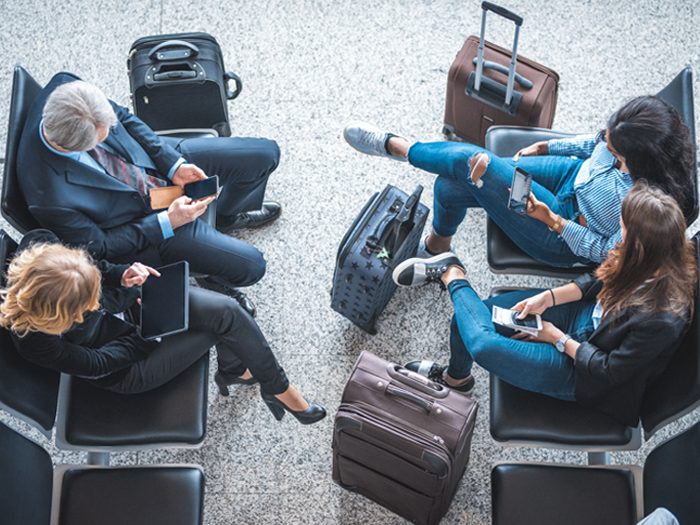Every Company Has Business Travel Risk. Here Are the Exposures You May Be Overlooking

What comes to mind when you hear “travel risk?” For business travelers, the phrase might evoke the possibility of threats to their safety while in the air or while traveling abroad, especially today given the tenuous state of geopolitical relations around the globe. Traveling within the U.S., the worst risk may seem to be a cancelled flight.
But travel risk exposure is much broader than that — something many companies and their insurance brokers may not fully appreciate, according to Jim Villa, head of accident and health at The Hartford.
We sat down with Villa to discuss some frequently overlooked business travel risks and what employers can do to better protect their employees on the road:
R&I: What are the most critical risks associated with business travel?
Jim Villa: The most critical risk is not fully appreciating the extent of your exposure.
When most people think about business travel risks, they’re thinking about airline travel or travel outside the U.S. Incidents that happen abroad tend to receive more attention and raise more concerns, including threats like terrorism or political unrest. However, risks for traveling employees can vary and can occur both domestically and internationally. Physical safety and security are the top priority wherever you travel.

Jim Villa, head of accident and health, The Hartford
Things can happen if you’re meeting a client at a local coffee shop, driving over to the next town or hopping on a plane from New York to California.
Companies often overlook the travel risks associated with local and domestic travel. Injuries, accidents and, unfortunately, tragedies happen every day while employees are traveling away from their home offices.
Risks are also present when an employee is on an overall business trip but is not actually working. For example, someone might take a few hours or a few days to explore the city they are visiting on their own personal time.
Risks when traveling internationally aren’t always related to emergency situations.
It could be a case of food poisoning that requires an employee to seek local care when traveling in another country. It could be a sprained ankle. It could be a lost passport.
When traveling outside of the U.S., most people don’t know who to reach out to or what steps to take in those situations. Business travel insurance provides resources to help employees get the help they need.
For example, if someone was to have an accident or emergency sickness in a country that does not have adequate medical care for their situation, our travel assistance company can arrange a medically supervised evacuation to the nearest facility that is capable of providing the proper treatment.
R&I: Why is it important to understand these risks? Is business travel increasing?
JV: There has been an uplift in people traveling. Small- and middle-market companies are increasingly seeking expansion opportunities outside the U.S., so international business travel is growing in that sector.
But even domestically, despite all of the virtual methods of communication we have today, companies continue to invest in making those face-to-face connections with customers and partners. So business travel both inside and outside the U.S. is as common as ever.
R&I: What types of companies are most exposed to business travel risks?
JV: Every company has business travel risk, and much of it is overlooked.
People sometimes think the number of employees will drive the risk. And sometimes that’s true.
But you can have a large manufacturing facility, for instance, that has hundreds of floor workers, and a small proportion of management staff who have a need to travel. Or you might have a startup run by five people, but all five travel extensively to promote and grow their business.
Some organizations like law firms or pharmaceutical companies may involve a lot of daily local travel by car. Others will require taking a 12-hour flight to conduct business in Asia.
But travel is travel. Certain industries necessitate more travel than others, but every organization carries some degree of risk.
R&I: How can employers best protect their traveling workforce?
JV: Companies should consider Business Travel Accident (BTA) insurance.
Typically, a company will gain access to a travel assistance provider through their insurer with this coverage. These providers will track safety risks and developing situations around the globe and send alerts. They also can provide general knowledge about customs and risks in different countries that employees can access on their own before traveling.
The Hartford, for example, offers a travel portal to clients through our travel assistance partner where they can see what’s going on around the world.
If you’re going to a country and you want to learn more about the security, any vaccinations you need, visas or other paperwork required, the health care that’s available, the safest way to get around, or the culture in general, you can find that information through the portal.
Although these services are often provided along with a business travel accident insurance policy, it’s incumbent upon the employer to share these resources with employees and raise the level of awareness and education.
R&I: What is the distinction between business travel accident insurance and workers’ comp? Wouldn’t workers’ comp cover the cost of care if an employee is injured while traveling?
JV: There’s a misconception that the coverages that come into play for traveling employees are either workers’ compensation or business travel accident. But it’s not just one or the other. BTA is meant to be complementary to workers’ comp and helps to fill some gaps.
Workers’ compensation will not necessarily cover an employee for the entire duration of their trip.
For example, a salesperson from Virginia is on a business trip to Texas decides to visit her friends for an evening who are located a few hours’ drive away from her work meetings. If she gets into a serious accident on the way, workers’ compensation may not cover that, because the employee was not explicitly involved in work-related activities.
Business travel coverage, however, begins the moment the employee leaves his or her home or workplace and extends until they arrive home again. There are no gaps.
Importantly, business travel insurance is not just about paying for emergency medical care after the fact. In addition to pre-travel educational resources, a BTA policy also provides for things like evacuation for either medical or security reasons or arranging guaranteed issuance into a local hospital in case of an illness or injury when traveling abroad.
They may also provide legal referrals and translation services, if needed.
R&I: What are the core coverages of a business travel accident policy?
JV: Coverage for accidental death and dismemberment has always been a core component.
Policies often include coverage for spouses and dependent children who are traveling with an insured employee.
Security evacuation, medical evacuation and emergency medical benefits, are all very important when traveling outside the U.S.
A wide range of travel assistance and support services are also valuable. However, business travel accident policies can vary widely and are often customized to the unique needs of the employer.
What’s unique about this product is that it started as a P&C product, moved over to the employee benefits side, and now over the last few years we’re seeing a shift back to the P&C market.
That transition is primarily because people are buying coverage not just for the AD&D, but for all of those other services that come with the policy. Employers realize they have a duty of care to mitigate any risks their employees face as they travel both within and outside the U.S. It is about helping to ensure the employee is safe throughout the duration of travel. &










